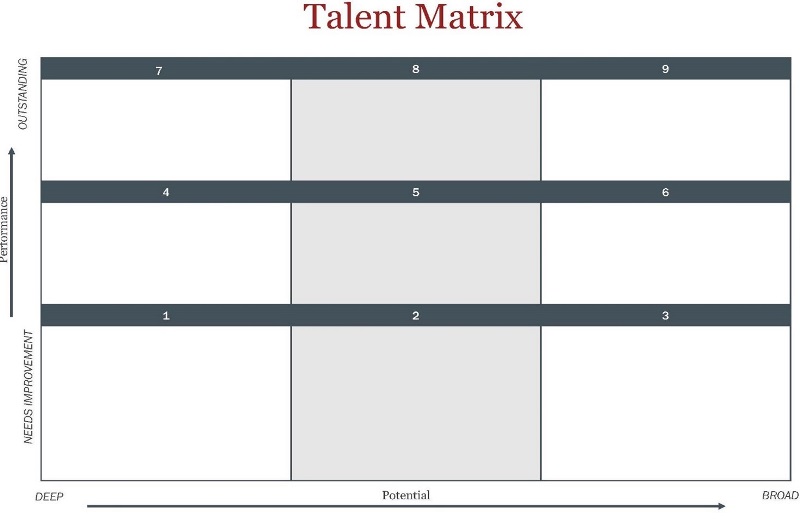Is the 9-box dead? Identifying Truly Human Potential

Related Insights
The usefulness of the 9-box matrix in talent management and succession planning has become a topic of considerable debate. The 9-box grid model consists of two axes—performance and potential—classifying employees into one of nine categories. This determines whether the individual has high or low potential. Historically, these ratings were determined by subjective perceptions from leaders, employee performance appraisals, performance reviews, and interactions.

Traditional categorization methods may sometimes trap team members in their designated "boxes," preventing leaders from recognizing their true potential if the focus isn't placed on the right attributes. Consequently, “high-potential” employees might miss out on relevant developmental opportunities because the constraints of the 9-box grid overlook their potential. In addition, high-performing employees may be given assignments meant for high-potentials when they are better suited to their current role. This is typically due to leaders misclassifying one’s current performance and/or future potential for a variety of reasons:
- Fear of losing star performers: Leaders may downplay a team member’s potential to keep them on their team.
- Desire to paint the team positively: Leaders may exaggerate their team’s capabilities using persuasive arguments that lack strong evidence.
- Neglecting to ask about aspirations: Leaders may not align their plans with team members’ career goals because they do not understand their aspirations.
- Misrepresenting employee readiness: Leaders lack sound definitions for readiness when considering a team member’s readiness. For example, many organizations ask leaders to assess whether an employee is “ready now” or “ready in 1-2 years” without identifying clear criteria to evaluate the level of readiness.
As a result, it's easy to dismiss the 9-box talent grid as just another corporate fad and move on to the next trendy, off-the-shelf solution for identifying high-potentials. However, rather than throwing the baby out with the bathwater, a more effective approach is to build on the success of this well-established tool while addressing its historical (mis)use.
How do you overcome the pitfalls of the 9-box grid?
Organizational researchers study ‘potential’ to help businesses identify future leaders based on scientific evidence. However, ‘potential’ is difficult to define and even harder to measure, leaving some aspects unclear. What is clear is that the terms HiPo (high-potential) and LoPo (low-potential) no longer belong in the 9-box. These labels misrepresent the unique differences in team members’ knowledge, skills, and abilities and can lead to pigeonholing and self-fulfilling prophecies, ultimately damaging team member engagement.
At Chapman & Co., we believe in Truly Human Potential. This means considering each team member’s unique talents and using objective perspectives to determine their potential for future leadership positions. This approach emphasizes a more holistic and humane way of evaluating and developing potential leaders, ensuring that assessments are fair, unbiased, and focused on each individual's unique resources and experiences. As a result, we advocate for the Korn Ferry taxonomy of ‘potential’ classifications, which are positioned along a spectrum: Broad and Deep potential. For simplicity, the extremes of each end of the spectrum are described below.
- Broad Potential: Quickly learns new functions, solves problems cleverly, thinks strategically, performs well under pressure, adapts easily, is broadly curious, handles complexity, challenges the status quo, and is willing to take the heat when driving change.
- Deep Potential: Recognized as a top functional/technical expert, thrives independently, performs consistently well, deeply knowledgeable about the organization, excels at developing others, trusted and well-regarded both inside and outside the company, and is promotable within their field.
Consider Simone Biles, who exemplifies broad potential through her versatility and adaptability in gymnastics. Like Biles, individuals with broad potential succeed across various challenges and roles, rapidly adapting to new situations. Biles performs impressively in multiple gymnastics disciplines and thrives in diverse routines, showcasing her ability to tackle a wide range of challenges easily. Her leadership and inspiring presence in the sport reflects how those with broad potential handle new responsibilities and drive positive change in various settings.
On the other hand, think of Stephen Nedoroscik, whose deep potential is evident in his exceptional skills on the pommel horse. Like Nedoroscik, individuals with deep potential consistently produce outstanding results within a specific area of expertise. While excelling in this specialized apparatus, Nedoroscik's mastery of the pommel horse demonstrates his deep expertise and focus. He may not venture beyond this specialty, but his mentorship and positive impact within his domain make him a key contributor and a potential future leader within his field.
Discovering Truly Human Potential
The Truly Human Potential framework recognizes that each employee's unique skills are valuable, whether broad or deep. For the organization, individuals with deep potential are ideally developed for functional leadership roles and mentoring, leveraging their expertise and engagement. Conversely, employees with broad potential benefit from diverse experiences that prepare them for broader business leadership roles in the future. Recognizing and nurturing both types of growth potential is crucial for driving business expansion, profitability, and innovation.
But how do we discover the Simone Biles and Stephen Nedorosciks within our teams? Gallup research highlights the value of combining objective and subjective assessments to better understand where leaders' depth versus breadth evaluations align or diverge. A key strategy involves using scientifically based talent assessments to identify an employee's strengths and development areas. These insights enable the creation of personalized development plans that address each individual's skill set and skill gaps, preparing them for the next level. Notably, Gallup's findings reveal that when predictive, validated psychological assessment metrics are used to evaluate candidates' leadership potential, the top quartile of leaders have a 46% greater chance of success, 13% higher team engagement, and 37% better financial outcomes. Why? By offering targeted growth opportunities tailored to the individual's strengths, aspirations, and readiness, organizations can optimize their team's full potential and sidestep the common pitfalls of traditional 9-box classifications.
Ready to assess the Truly Human Potential of your leaders?







